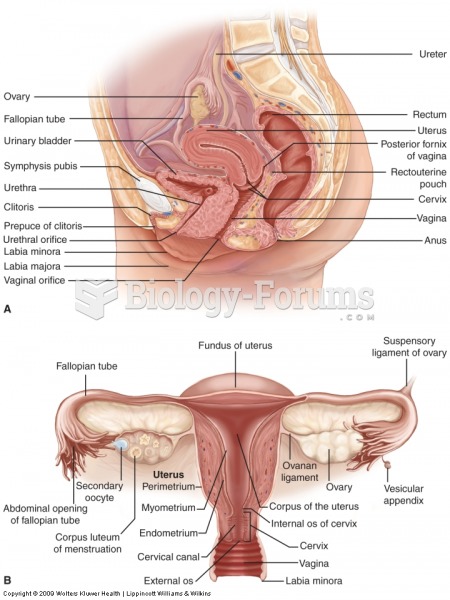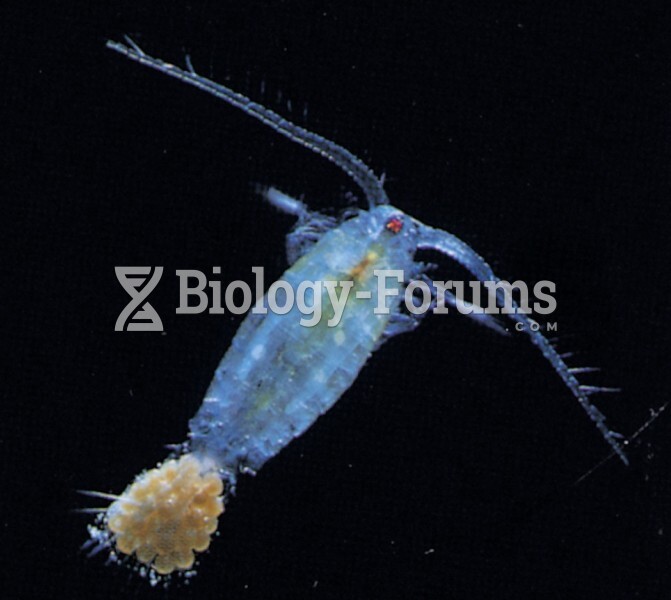Answer to Question 1A whelping box provides a nice place for the female to have her puppies. She should be introduced to her box
about three weeks before whelping so that she can get comfortable with it. The bottom of the box should be
covered with newspaper.
A normal, healthy female usually gives birth easily without need of additional help; however, one should
stand by and give assistance if necessary. One must be prepared to help the mother remove a puppy from
its placental membrane, to clean it, and encourage it to nurse. When cleaning a membrane off a puppy, the
owner may also have to sever the umbilical cord. A piece of cotton thread should be tied around the cord
about three-quarters inch to one inch away from the puppy's body; the cord should then be cut one-quarter
inch to half an inch beyond the thread, taking care not to pull on the cord and making sure the hands are
clean. An application of iodine to the naval cord is recommended. One must be careful of the mother also,
because she may be protective of the litter and may bite.
The first milk produced by the mother is called colostrum. It is very important that each puppy receive
colostrum because it contains immunoglobulins that will help protect it from infectious disease.
Eclampsia is a calcium deficiency that may be observed shortly after whelping and during the first
month of lactation. It usually occurs among toy breeds and females with large litters that require a large milk
production. Symptoms include restlessness, panting, whining, and getting up and down. As the problem
worsens, the dog will become still, experiencing twitching muscles, and lack coordination. If not treated, she
will collapse into convulsions and die. A veterinarian must be consulted immediately to give her a calcium
injection. Prevention can be accomplished by ensuring the pregnant female gets proper vitamin and mineral
supplements, especially calcium.
Answer to Question 2Infectious Diseases
Canine distemperEarly symptoms are vomiting and diarrhea; later, signs of nervous system damage
appear, ranging from tremors to full seizure activity. The dog will eventually die or have permanent
nervous system damage.
Infectious canine hepatitisThe virus targets the liver, kidneys, spleen, and lungs. Long-term kidney
damage can occur, and the cornea of the eyes may become clouded. Signs vary from slight fever to death.
Affected animals may appear dull and apathetic. They usually refuse to eat and may have an intense
thirst. The body temperature increases, and swelling may occur in the head, neck, and lower portion of
the abdomen. The dog may moan in pain when eliminating. The gums may be yellow, and sometimes
hemorrhages appear on them; the tonsils are enlarged and painful. Most dogs will recover or are dead
within 36 hours after initial signs.
LeptospirosisSympto ms include high fever, loss of appetite, vomiting, and diarrhea; dehydration and
depression occur. Reddening of the membranes of the eyes and mouth are common. In some cases,
yellowing of the gums and whites of the eyes may occur. The disease attacks the kidneys, liver, and
gastrointestinal tract, causing pain and discomfort. Death usually occurs from severe damage to the liver
and kidneys.
Canine parvovirus infectionIn the intestinal form, the virus grows in the epithelial cells of the small
intestine and rapidly destroys them. Early signs are vomiting followed by diarrhea, refusal to eat, and
severe dehydration. The feces appear yellow-gray and are often streaked with or darkened by blood. Dogs
may vomit repeatedly and have projectile and bloody diarrhea until they die. Most deaths occur within
4872 hours following onset of clinical signs.
The heart form may be preceded by the intestinal form or may occur without apparent previous disease.
The virus rapidly attacks the muscle cells of the growing heart. Pups may act depressed and stop suckling
shortly before they collapse, gasping for breath. Pups that may survive may have damaged hearts and
die from heart failure weeks or months later.
Infectious tracheobronchitisTh e disease is marked by coughing and, in some cases, fever, loss of appetite,
and pneumonia.
RabiesSigns of rabies develop within two weeks to three months after the bite has occurred. During
early signs of furious rabies, the animal may act strangely. It may be unnaturally withdrawn or abnormally
affectionate. This stage usually lasts about two days and then is followed by the mad stage, in which the
animal will attack and bite anything in its path. A common symptom of this stage is frothing at the mouth,
which is caused by difficulty in swallowing. Eventually, the animal lapses into a paralytic state and then dies.
Dumb rabies differs in that there is no wandering or mad stage. Paralysis of the lower jaw is usually
one of the first signs, followed by paralysis of the limbs and vital organs, resulting in death.
CoronavirusThis disease is characterized by severe vomiting and diarrhea. The feces are usually orange
and foul smelling, and may be streaked with blood.
Canine brucellosisIn females, canine brucellosis results in abortion 45 to 55 days into the gestation
period. Other signs are embryonic death and resorption, or abortion at 10 to 20 days after mating. In
males, the scrotum and testicles swell, and one of both testes may also atrophy. Infected animals may show
no sign of disease.
Canine herpes virusThis virus results in severe illness and death in puppies less than six weeks old.
Symptoms include a change in color of feces, difficulty in breathing, abdominal pain, ceasing to nurse, and
constant crying. Affected puppies die shortly after the symptoms appear.
SalmonellosisThis disease presents as fever, diarrhea, and vomiting. Dehydration and severe inactivity
usually accompany these signs of infection.
HaemobartonellosisD epression, loss of appetite, weight loss, and fever are the primary symptoms.
Gastrointestinal campylobacteriosisT he symptoms are loss of appetite, inactivity, and diarrhea.
Noninfectious Diseases
Heart diseaseThis disease is characterized by coughing at night during sleep, coughing during exercise,
inability to exercise, fainting spells during exercise, development of blue gums during exercise, openmouth
breathing at rest, reluctance or inability to breathe when lying down, and development of a large,
pendulous abdomen because of accumulation of fluid.
CataractsA cloudy, white opacity of the lens indicates cataracts.
GlaucomaThis disease involves an increase in pressure within the eyeball, caused by a variety of
problems with the production, transport, and absorption of aqueous humor, the fluid within the eye.
Progressive retinal atrophy (PRA)PRA leads to a loss of sight. The first signs are loss of night vision; dogs
undergo behavior changes, especially when light is limited.
Cherry eyeThis appears as a red, cherry-like growth.
Hip dysplasiaHip dysplasia results in hind-leg lameness because of pain originating in the malformed
ball-and-socket joint.
ArthritisPain, lameness, and stiffness in the joints are the symptoms of arthritis.
TetanusSpasms of the facial muscles indicate tetanus. Spastic paralysis; lockjaw; inability to stand;
prolapse of the third eyelid; and overextended head, neck, and legs may be seen as the disease
progresses. Death usually occurs because the disease affects the respiratory muscles, and other
complications set in.
BotulismA paralyzing effect at the junction of the muscles and nerves indicates botulism. The animal
usually loses total muscle function and dies.
Anal sac blockageThe anal sacs may become swollen and painful, and the dog may be seen licking the
area and dragging its rear on the ground.
Fungal Diseases
RingwormRingworm is characterized by broken hairs around the face, ears, or feet. Reddened and scaly
skin develops; in severe cases, scaling and crusting accumulate, and the skin becomes thickened and itchy.
A characteristic redness develops around a healing center as the disease progresses.
BlastomycosisCoughi ng, rapid breathing, lack of appetite, eye problems, lameness, and skin problems are
signs of blastomycosis.
HistoplasmosisIf the lungs are infected, there will be coughing, respiratory difficulties, fever, and
depression. If the intestines are infected, the signs will be diarrhea, weight loss, and fever.
CoccidioidomycosisE arly signs are lack of appetite and loss of weight. Later on, as the disease progresses,
signs include lameness, bone pain, spinal pain, and coughing.
Internal Parasites
Ascarids, commonly called roundwormsSymptoms depend on the number of worms present. There
may be no signs of the worms if only a few are present, but if several hundred are growing to adults, the
abdomen will distend, giving the pup a potbellied appearance.
HookwormsAnemia is the result of hookworms. The loss of blood into the intestine results in darkcolored
feces. Gums of the animal will be white, and the animal will appear weak and listless.
WhipwormsResultant irritation to the gut lining causes a loss of tissue fluids, which results in watery
feces usually tinged with blood. Dogs will become dehydrated and if not treated will die.
TapewormsThese are not harmful to the dog, but can be transmitted to humans, where they can cause
serious illness.
HeartwormFrequent coughing, sluggishness, rapid tiring, and rapid breathing are symptoms of
heartworm.
External Parasites
FleasFleas cause irritation and allergic reaction to severe itching. Biting and scratching around the rump
and groin areas are the most common signs of flea allergy. Hair loss, a red rash, and thickening of the skin
are also commonly seen.
Ticksthe larvae and nymphs can cause severe irritations to the ear canal and may occasionally cause
paralysis and seizures in some animals.
LiceLice can cause severe hair loss from scratching and rubbing.
MitesDemodectic mites cause demodicosis. The localized form causes patchy hair loss on the head,
forelegs, and trunk. The generalized form causes hair loss, reddening, and crusting and may involve the
entire body. Dogs with generalized form may also develop bacterial infections in the skin.
Saroptic mites cause constant scratching, chewing, and rubbing of the affected areas, producing reddening,
scaling, and crusting of the skin. The head, ears, and abdomen are most usually affected, but the entire
body may become infected. Many times, animals will cause self-inflicted injuries as they scratch, chew, and
rub the skin.
Ear mitesAn animal with ear mites may show signs ranging from no symptoms to severe irritation
with thick, dry, black crusts in the ear canals.
Cheyletiella mites cause cheyletiellosis, a condition referred to as walking dandruff, which produces
severe scaling, usually on the back of the infected animal.
ChiggersThese cause an itchy, red rash on the belly, face, feet, and legs.
PoisoningsSymptoms of poisoning vary depending on the type of poison consumed. Treating animals
that have been poisoned must begin as soon as a pet owner recognizes a poison is involved; prompt
diagnosis and treatment are extremely important.






